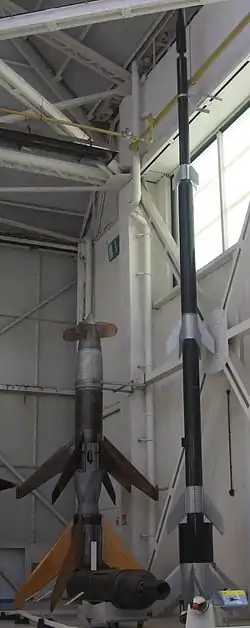Rheinbote
Rheinbote (Rhine Messenger, or V4[1]) was a German short range ballistic rocket developed by Rheinmetall-Borsig at Berlin-Marienfelde during World War II.[2] It was intended to replace, or at least supplement, large-bore artillery by providing fire support at long ranges in an easily transportable form.

History
One of the problems for the German military, and indeed any mobile military force, is the weight of the artillery and, more importantly, its ammunition supply. Battlefield rockets were intended to circumvent the problems, which led to the development of Rheinbote. The Rheinbote was the successor of the earlier Rheintochter (Rhine Maiden).[3]
Developed in 1943 by the Rheinmetall-Borsig company, Rheinbote was a four-stage solid-fuelled rocket, and the only long-range battlefield ballistic missile to enter service in World War II.[4] The first test flights were carried out that year. Several changes were made to the system, but the basic design remained the same. It measured 11.4 m (37 ft 5 in), with fins at the tail and one set of additional fins at each stage.[5] The propellant was a diglycol dinitrate mix, which enabled test models to achieve a speed of 6,800 km/h (4,200 mph; 3,700 kn), the fastest rocket of the period.[5]
The Rheinbote carried a 40 kg (88 lb) warhead (just 2.3% of the missile's total weight)[5] to a height of 78,000 m (256,000 ft),[5] for an effective range of 160 km (99 mi; 86 nmi); it reached over 220 km (140 mi; 120 nmi) in testing.[5] For shorter ranges, some of the stages could be removed. It was launched from a simple rail on a mobile trailer, based on the one used to transport the V-2.[5] It was aimed simply by pointing the trailer and elevating the launch gantry, a method not guaranteed to be accurate.[5]
Over 220 were constructed,[6] with over 200 being used against the Belgian port of Antwerp between November 1944 and the end of the war.[5] They caused only limited damage in small unpredictable areas of the city.[7]
Some were fired from positions near the town of Nunspeet in the Netherlands.
The concept of long-range artillery rockets on the battlefield would remain undeveloped after the war. Even Rheinbote was not used in its intended role, but instead as a smaller version of the V-2 missile in the strategic role, for which its warhead was essentially useless due to its poor accuracy, small size, and its fusing, since it tended to bury itself in the ground before exploding.[5]
After the war, the Soviet Union seized the design.[5]
Design
The Rheinbote was a four-stage solid fuel rocket. The slender body measured in at 11.4 m (37 ft) tall and could carry a relatively small payload over a distance of approximately 200 km (120 mi). Each of the four stages fired in succession with the first stage getting the rocket off the ground, the second and third stages lifting it further aloft, and the fourth stage lifting it to its maximum altitude. It was a ballistic missile with relatively low accuracy. Upon detonation the warhead produced no fragment damage and produced a crater no larger than 1.5 m (4.9 ft) across. The accuracy of the Rheinbote was found impossible to calculate after tests, because the craters proved too small to find.[7]
Characteristics
- Primary function: artillery support
- Contractor: Rheinmetall-Borsig
- Fuel source: diglycol-dinitrate solid propellant rocket[7]
- Length: 11.4 m (37 ft 5 in)[7]
- Diameter:
- Wingspan:
- Launch weight: 1,709 kg (3,768 lb)[8]
- Speed: 6,800 km/h (4,200 mph; 3,700 kn)
- Warhead: 40 kg (88 lb)
- Range: 160 km (99 mi; 86 nmi) (effective); 220 km (140 mi; 120 nmi) (maximum)
- Fuzes:
- Unit cost:
- Date deployed: November 1944
- Users: Germany
Notes
- "Rakete Rheinbote V4". 2015-08-15. Archived from the original on 2015-08-15. Retrieved 2020-04-10.
- Christopher, John. The Race for Hitler's X-Planes (The Mill, Gloucestershire: History Press, 2013), pp.136-7.
- Ford, Brian J., Secret Weapons, Osprey Publishing, 2011, p.84, ISBN 978 1 84908 390 4
- Christopher, p.136.
- Christopher, p.137.
- Christopher, p.137, says "over 200".
- Ford, p.84
- Christopher, p.137, suggests the missile's weight was nearer 615 kg (1,356 lb).
Sources
- Christopher, John (2012). The Race for Hitler's X-Planes : Britain's 1945 Mission to Capture Secret Luftwaffe Technology. Stroud: History Press. ISBN 978-0-7524-6457-2.
- Ford, Brian (2011). Secret weapons : technology, science & the race to win World War II. Oxford Long Island City, NY: Osprey. ISBN 978-1-84908-390-4.
- Koopman, Henk (2018). Vergeltungswaffen in Nederland : inzet van de V1, V2 & V4 vanaf Nederlands grondgebied 1944–1945 (in Dutch). Utrecht: Flying Pencil. ISBN 9789081870221.